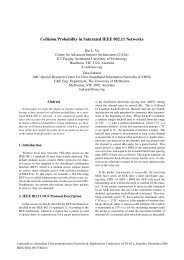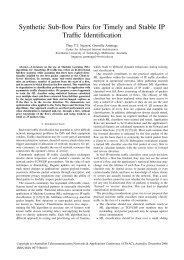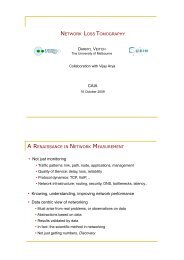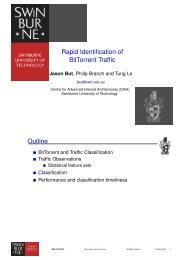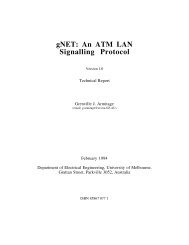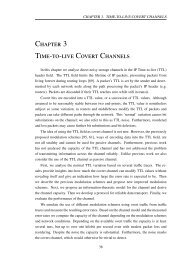Mitigating Sampling Error when Measuring Internet Client IPv6 ...
Mitigating Sampling Error when Measuring Internet Client IPv6 ...
Mitigating Sampling Error when Measuring Internet Client IPv6 ...
Create successful ePaper yourself
Turn your PDF publications into a flip-book with our unique Google optimized e-Paper software.
Percentage of capable that prefer <strong>IPv6</strong> (native, 6to4, Teredo)<br />
<strong>IPv6</strong>−capable connections<br />
preferring <strong>IPv6</strong> [%]<br />
100<br />
80<br />
60<br />
40<br />
20<br />
0<br />
●<br />
16May<br />
2011<br />
●<br />
● Native WD<br />
Native WE<br />
6to4 WD<br />
6to4 WE<br />
25Jun<br />
2011<br />
04Aug<br />
2011<br />
●<br />
13Sep<br />
2011<br />
Date<br />
● ● ●<br />
23Oct<br />
2011<br />
02Dec<br />
2011<br />
11Jan<br />
2012<br />
20Feb<br />
2012<br />
Figure 11: Percentage of <strong>IPv6</strong>-capable connections that preferred<br />
<strong>IPv6</strong> in dual-stack (native <strong>IPv6</strong>, 6to4). Capable clients<br />
with Teredo never preferred <strong>IPv6</strong>.<br />
Percentage of <strong>IPv6</strong> capable by OS<br />
<strong>IPv6</strong>−capable connections [%]<br />
15<br />
10<br />
5<br />
0<br />
● ●<br />
16May<br />
2011<br />
25Jun<br />
2011<br />
04Aug<br />
2011<br />
●<br />
● MacOSX<br />
Linux<br />
iOS<br />
13Sep<br />
2011<br />
Date<br />
● ●<br />
23Oct<br />
2011<br />
02Dec<br />
2011<br />
Windows<br />
MiscMobile<br />
Unidentified<br />
11Jan<br />
2012<br />
●<br />
20Feb<br />
2012<br />
Figure 12: Percentage of all connections from <strong>IPv6</strong>-capable<br />
hosts by operating system<br />
5.2 Operating system <strong>IPv6</strong> capabilities<br />
Figure 12 shows the percentages of <strong>IPv6</strong>-capable connections<br />
and Figure 13 shows the percentage of connections from <strong>IPv6</strong>capable<br />
clients that preferred <strong>IPv6</strong> for different OSs. 5 Over 6%<br />
of connections were from <strong>IPv6</strong>-capable Windows clients, but only<br />
for 20% of these (with native <strong>IPv6</strong>) the clients actually preferred<br />
to use <strong>IPv6</strong> in dual-stack. In contrast MacOS X and Linux clients<br />
have a similar 6–7% of <strong>IPv6</strong>-capable connections, but most of them<br />
were native <strong>IPv6</strong> and preferred to use <strong>IPv6</strong> in dual-stack. Only 1–<br />
2% of connections came from <strong>IPv6</strong>-capable iOS clients, but about<br />
30–40% (with native <strong>IPv6</strong>) preferred <strong>IPv6</strong> in dual-stack. 6<br />
Figure 12 shows a significantly increased <strong>IPv6</strong>-capability for<br />
Linux around <strong>IPv6</strong>-day 2011. Many of the connections came from<br />
Ubuntu clients that enabled <strong>IPv6</strong> via point-to-point tunnels on that<br />
day and even for a few weeks afterwards. In the raw data the spike<br />
is even higher (up to 30%), since multiple of our participating web<br />
sites were monitored by a company that uses Ubuntu-based probes<br />
located in different countries. We filtered out these probes as they<br />
are not “genuine” clients.<br />
5 We distinguish between MacOS X, Linux, BSD variants, Solaris,<br />
iOS, Windows, mobile OS (Symbian, BlackBerry, and Android),<br />
and unidentified OS. OSs with too few occurrences are not shown.<br />
6 Note that due to the low number of observed <strong>IPv6</strong>-capable iOS<br />
connections the standard error here is 5–10%.<br />
Percentage of <strong>IPv6</strong> capable that preferd <strong>IPv6</strong> in dual−stack by OS<br />
<strong>IPv6</strong>−capable connections<br />
preferring <strong>IPv6</strong> [%]<br />
100<br />
80<br />
60<br />
40<br />
20<br />
0<br />
●<br />
16May<br />
2011<br />
●<br />
25Jun<br />
2011<br />
04Aug<br />
2011<br />
● ●<br />
● MacOSX Linux iOS Windows<br />
13Sep<br />
2011<br />
Date<br />
23Oct<br />
2011<br />
●<br />
02Dec<br />
2011<br />
11Jan<br />
2012<br />
●<br />
20Feb<br />
2012<br />
Figure 13: Percentage of <strong>IPv6</strong>-capable connections where the<br />
host preferred <strong>IPv6</strong> by operating system<br />
Windows <strong>IPv6</strong> capabilities<br />
<strong>IPv6</strong> forced, capable connections [%]<br />
60<br />
50<br />
40<br />
30<br />
20<br />
10<br />
0<br />
● Win XP capable<br />
Win XP forced<br />
●<br />
16May<br />
2011<br />
25Jun<br />
2011<br />
04Aug<br />
2011<br />
Win Vista capable<br />
Win Vista forced<br />
● ● ● ● ●<br />
13Sep<br />
2011<br />
Date<br />
23Oct<br />
2011<br />
02Dec<br />
2011<br />
Win 7 capable<br />
Win 7 forced<br />
11Jan<br />
2012<br />
20Feb<br />
2012<br />
Figure 14: Percentage of <strong>IPv6</strong>-capable and <strong>IPv6</strong>-forced for<br />
Windows XP, Vista, and 7 connections<br />
Figure 14 shows the percentages of <strong>IPv6</strong>-capable and <strong>IPv6</strong>forced<br />
connections for all connections of each Windows version<br />
(Windows XP, Vista, and 7 only, as 99% of the tested Windows<br />
clients ran these versions). Only 1% of connections from Windows<br />
XP hosts were <strong>IPv6</strong>-capable and the percentage of <strong>IPv6</strong>-forced was<br />
equally low (6to4 and Teredo are not enabled by default on Windows<br />
XP). Windows Vista and Windows 7 had a similar 10% of<br />
<strong>IPv6</strong>-capable connections, but the percentage of <strong>IPv6</strong>-forced was<br />
20% larger for Windows 7 (6to4 and Teredo are enabled by default<br />
on Windows Vista and 7, but the lower <strong>IPv6</strong>-forced percentage suggests<br />
that Teredo was either disabled or failed to establish a tunnel<br />
more often on Vista [32]).<br />
The percentages of connections from <strong>IPv6</strong>-capable Windows XP,<br />
Vista and 7 clients that preferred <strong>IPv6</strong> in dual stack were 20–30%,<br />
10%, and 20% respectively (since there were no significant trends<br />
we omitted the figure). Windows XP has the highest <strong>IPv6</strong>-preferred<br />
(native IP) percentage, which is not very surprising since in contrast<br />
to Windows Vista or 7 6to4 is not enabled by default. The<br />
<strong>IPv6</strong>-preferred percentage is significantly higher for Windows 7<br />
than for Windows Vista, maybe because more <strong>IPv6</strong>-savy Windows<br />
users avoid Vista.<br />
5.3 <strong>Client</strong> sample dependencies<br />
Figure 15 compares the <strong>IPv6</strong>-forced, <strong>IPv6</strong>-capable and <strong>IPv6</strong>preferred<br />
proportions for JS-tests and FA-tests. <strong>IPv6</strong>-forced was<br />
higher for FA-tests since the proportion of Windows was higher.



